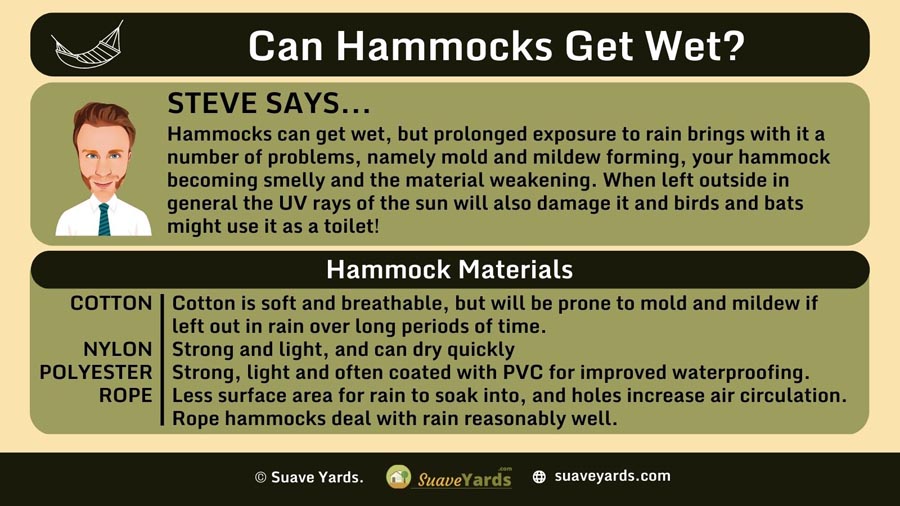
In most major towns and cities, rain is going to make an appearance at one point or another.
And if you have a hammock set up for the summer, you might wonder if it really is worth taking it down during those warmer months.
I mean can hammocks stay outside? What harm can a bit of rain do?
That is what we are going to be looking at today – can hammocks get wet? And can they stay outside?
So let’s get started…
Can Hammocks Get Wet? (And Can They Stay Outside?)
Hammocks can get wet, but prolonged exposure to rain brings with it a number of problems, namely mold and mildew forming, your hammock becoming smelly and the material weakening. When left outside in general the UV rays of the sun will also damage it and birds and bats might use it as a toilet!
Leaving A Hammock Out in the Rain: Potential Problems
Most hammocks are not waterproof and for good reason.
Imagine you set your hammock up for a quick siesta in the afternoon sun, but there is an unexpectedly short burst of heavy rain.
If it is waterproof you will return to something akin to a suspended bucket of water hanging above the ground.
Likewise on a warm sunny day, the hammock would be coated in your sweat.
In general if you leave your hammock out overnight in the occasional rainstorm, you’ll be ok.
But leaving it out for weeks or months on end, so it gets soaked and then dries continually is not going to be good for it no matter what material it is made from and how expensive it is.
Either way, if you let your hammock get wet then it is at risk of a number of problems including:
Mold and Mildew
Leaving any kind of material outside in weather that is at times damp and cold can lead to mold and mildew forming on it.
This can be very difficult to get rid of and also a health risk if you are sensitive to mold spores.
It can then lead to other problems, including…
Smell
I am sure we have all faced that age-old problem associated with damp clothing.
I used to play a lot of soccer, and occasionally I would accidentally leave an old jersey or pair of socks in my kit bag without realizing.
What would I be confronted with when I opened the bag after a week or so?
A very pungent and unpleasant smell!
The same thing will happen if you allow your hammock to get wet and then dry numerous times – it will begin to smell.
Damage
Prolonged exposure to water will damage the fibers of the hammock, no matter what material it is made of.
If there is fungus or mold on it, this will spread quickly the longer it is left out in the damp, and the material will get weaker and weaker and then tear completely.
What You Should Do if Your Hammock Gets Wet?

If your hammock does get wet you should always try and thoroughly dry it before you store it away or sleep in it again.
Your best way to dry it is by finding a warm place, that is not in direct sunlight.
A simple way to do this could be by setting it up in your garage, or in a vacant area of your home.
It goes without saying that if you use a metal hammock stand, leaving it out in the rain will cause rust.
Does It Make A Difference What Material My Hammock is Made From?
Most hammocks are made in one of four materials, each having its own unique benefits.
Let’s take a closer at the most common materials hammocks are made from.
Cotton Hammocks
The very first hammocks were thought to be found in the rainforests of South America and made from Brazilian cotton.
So cotton has a long-standing tradition as a good material to make hammocks from.
Cotton is soft and breathable, which is why is so widely used.
It is at home in relatively moist conditions, but won’t be happy in constant rain or dampness as it will lead to mold forming and deterioration of the hammock.
- Can Cotton Hammocks Get Wet?
No. They should not be left outdoors during periods of sustained rain.
Nylon Hammocks
Nylon is a popular material for many camping hammocks. This is because it is strong and light, and also very quick to dry.
Nylon hammocks can often easily be coated with water repellent to give them extra protection against the elements.
- Can Nylon Hammocks Get Wet?
Nylon hammocks fare better against the rain than most, as they dry quickly and can repel rain more than other materials.
Polyester Hammocks
Polyester is probably one step up from Nylon when it comes to hammocks, and, if anything, it is even more water resistant.
Polyester hammocks are coated with PVC to improve their waterproof properties and are also strong, light and easy to dry.
- Can Polyester Hammocks Get Wet?
Polyester hammocks are amongst the ablest to put up with getting wet, thanks to their strong waterproof properties and the fact they dry quickly.
Rope Hammocks

A number of years ago I was lucky enough to go to Fiji, a beautiful tropical island where sunshine, amazing sunsets and beautiful white sand beaches are common features.
Also a feature was occasional tropical rainstorms.
At every resort I stayed at there were plenty of hammocks for lazing on the beach, and they were all rope hammocks.
Obviously water cannot accumulate or saturate rope hammocks due to their holes, which also increase air circulation.
- Can Rope Hammocks Get Wet?
Rope hammocks can definitely deal with rain a lot better than most materials as there is less surface area for the rain to soak into.
Can Hammocks Stay Outside? 3 Other Risks
So we’ve learned about the dangers of leaving your hammock out in the rain, but what are the other risks of leaving a hammock outside?
Let’s take a closer look.
The Sun
If you live in a predominantly dry area, you might think it is fine to leave your hammock out all summer long.
But actually the harmful UV rays of the sun can do as much damage to a hammock as the rain.
UV rays are the enemy of any synthetic material and will weaken the fibers of a hammock that is left out in it for too long.
The compromise here (aside from bringing your hammock in), is to locate it in a shady place or to protect with a tarp or something similar.
Animals
Leave a hammock out for any prolonged time, and you can almost guarantee it will attract the attention of birds, bats and possibly other animals.
That is to say they could well leave their ‘mark’ on it, and not in the nicest fashion.
A tarp covering could again do a job in keeping bird and animal droppings off of your hammock.
Wind and Branches
Another enemy of a hammock is the wind.
When no one is in it the wind could easily catch hold of it and spin it around where it might catch on a low tree branch and tear the fabric.
Final Thoughts

The answer to the questions of if a hammock can get wet and if it can stay outside is yes but with a condition attached.
Some materials will be better at dealing with rain than others.
For instance a rope hammock has very little surface area to absorb water, and thus problems like mold formation and weakening of the fibers are less of a problem.
In short, any kind of hammock can be left out in the rain for a day or two, maybe even a few days, but if is left out in the rain for a prolonged period of time then expect the material to become moldy and structurally weaker.
The same goes for leaving a hammock outside in general.
Even if the weather is good I would never leave a hammock outside for too long, as the UV rays of the sun can be just as damaging as the rain.
If you want your hammock to last, take it down and bring it inside regularly!
